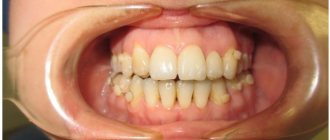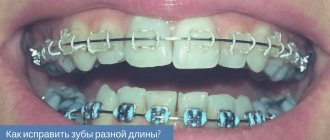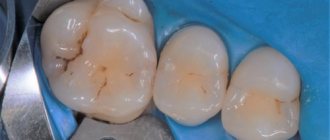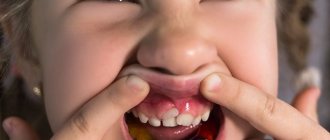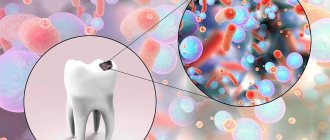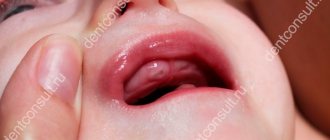25.11.2019
Unfortunately, people don't really like visiting the dentist. The procedure may seem very unpleasant and painful. However, to maintain dental health, you must visit the dentist at least twice a year. If you have problems with your teeth, you will have to visit the doctor more often. In this article we will tell you what to do if your teeth are loose.
Unfortunately, people don't really like visiting the dentist. The procedure may seem very unpleasant and painful. However, to maintain dental health, you must visit the dentist at least twice a year. If you have problems with your teeth, you will have to visit the doctor more often. In this article we will tell you what to do if your teeth are loose.
Why are teeth loose?
In childhood, loosening of teeth is physiological and does not require doctor’s intervention if it does not cause a lot of inconvenience to the child and does not interfere with the eruption of permanent teeth.
Why do teeth become loose?
- Physiological reasons
- Pathological causes
Physiological loosening is observed in preschool children when they change their baby teeth to permanent ones. In this case, their loosening is absolutely normal, since baby teeth do not have roots and do not sit tightly in the surrounding tissues. They are replaced by permanent teeth, which have a root connected to the bone tissue of the skull.
What are the recommendations and restrictions after gum recession surgery?
- Do not disturb the wound surface (with tongue, food, foreign objects, etc.) this is the main condition for good healing.
- Do not bite (food eaten should be soft or finely chopped).
- Do not brush your teeth in the surgical area with a toothbrush (hygiene in this area should be maintained only as permitted by the attending physician).
- Do not eat or drink hot foods.
- Avoid physical activity.
- Follow the recommendations of your doctor and take prescribed medications.
An adult's teeth are loose: reasons
In adulthood, teeth also have a certain amount of looseness. Many people think that they are absolutely motionless, but this is not so. Minor vibrations of the teeth in the gums are allowed; this is literally a fraction of a millimeter, allowing you to chew food. If there were not these small gaps and movement of the teeth, then, most likely, they would crumble with the destruction of the jaw and skull bones.
However, significant loosening of the teeth, over a distance of approximately 1 mm in both directions, is considered pathological and can cause tooth loss. Such problems most often require a doctor’s examination and consultation. There are several reasons why teeth become loose in adults.
An adult's teeth are loose, reasons:
- Gingivitis
- Periodontitis
- Periodontitis
- Periodontal disease
All these diseases require treatment, which can be carried out both surgically, with the assistance of orthodontists, and at home. It all depends on the specific ailment.
My front teeth are loose, what should I do?
Risk category:
- The disease most often occurs in children between 3 and 6 years of age.
- Diabetes
- Women taking hormones and oral contraceptives
- Complications after ARVI and sore throat, as well as influenza
My front teeth are loose, what to do:
- With gingivitis, the gums become inflamed and an infection penetrates into the gum pocket, which destroys the tissue and contributes to the loosening of the tooth. To cope with this problem, you need to thoroughly clean your teeth, use dental floss, irrigators, and special medications.
- Dentists often prescribe antiseptics to disinfect the cavity and prevent bacteria from growing in the pockets that form between the tooth and gum. Next, strengthening agents are prescribed that help make the gums denser and more elastic.
- The prognosis for the treatment of gingivitis is positive, since the connection between the gum and tooth is not disturbed, and only inflammation of the gums is observed. With proper treatment, it is possible to completely get rid of loose teeth and heal all kinds of wounds.
Summary -
In this article, we briefly listed the main stages of treatment necessary to quickly relieve inflammation. Removing dental deposits from teeth and anti-inflammatory therapy will relieve redness, swelling, bleeding of the gums, the gums will become denser, pale pink in color, and bad breath will disappear. However, the treatment of a disease such as periodontitis does not end there.
In the case of deep periodontal pockets, and when the gums move away from the teeth, it can be assumed with a high degree of probability that splinting of mobile teeth will be required, as well as one of the surgical methods for treating periodontitis (for example, flap surgery or open curettage of the gums). During flap surgery, a thin strip of marginal gum is removed, which is loose and not attached to the teeth and, accordingly, this reduces the depth of periodontal pockets, as well as the rate of progression of periodontitis.
Sources:
1. Dental education of the author of the article, 2. Based on personal experience as a periodontist, 3. National Library of Medicine (USA), 4. American Academy of Periodontology (USA), 5. “Therapeutic dentistry. Textbook" (Borovsky E.V.).
Treatment of loose teeth due to gingivitis
Pathology occurs in case of complications of nasal breathing, chronic rhinitis or sinusitis, as well as a deviated nasal septum.
Treatment of loose teeth with gingivitis:
- Most often, gingivitis is treated on an outpatient basis, and if all the doctor’s recommendations are followed, it can be cured. For treatment, antibacterial agents are often used, which are used not only topically, but also internally. However, this method of treatment is used only in advanced cases when gingivitis progresses to periodontitis.
- To treat gingivitis, cephalosporin antibiotics, Penicillin, and Doxycycline are used. Hepilor, Givalex, and astringent liquids are used as rinses, which help disinfect the oral cavity and prevent the growth of bacteria.
- You can also use a solution of Miramistin, Chlorhexidine. Sometimes Decasan applications are used. These are all antiseptics that help eliminate pathogenic microorganisms. This applies not only to bacteria, but also to viruses and fungi that cause gingivitis.
Firming massage
Strengthens loose gums by improving blood flow through massage. Hands must be clean or wear sterile gloves and finger caps. The effect is enhanced by adding pine needle paste, honey or a suitable essential oil.
Grab the jaw with the 1st and 2nd fingers of the hand and massage the loose gums along the jaw in smooth circles for 5–7 minutes, without applying pressure. After the massage, rinse with an antiseptic.
You cannot massage if there is gum bleeding.
How to strengthen your gums if your teeth are loose?
A fairly common cause of loose teeth is periodontal disease. This is the destruction of the tissues that surround the teeth, with the transition to the bone. As a result, the tooth initially becomes loose and then falls out.
How to strengthen your gums if your teeth are loose:
- There are several methods of treating this disease, the most popular are dental ones, which are carried out in the doctor’s office. A modern dentist has a huge number of instruments and devices that help cope with periodontal disease.
- At the initial stage, a treatment is carried out during which all plaque and tartar are removed, where bacteria and microorganisms that destroy the gums accumulate. Next, after cleaning, laser treatment can be carried out, during which the inflamed tissue drains and the areas surrounding the tooth are restored. After healing, the teeth are restored and no longer become loose.
- Also in dentistry, the help of an orthodontist is often used. If one specific tooth is loose, it has been treated, and there is no inflammation, then a kind of splint is often used. These are plastic or metal overlays that are fixed to the teeth using a special compound.
- Don’t worry, these products are attached on the side of the tongue, so they are not visible at all during a conversation, as well as a smile. Thanks to such splints, a loose tooth is fixed to two nearby ones, thereby stopping its destruction and loss.
Products that can help improve the situation
In the human body, a lot depends on nutrition. It is impossible to have a healthy smile if you consume a huge amount of junk food every day. If a person wants to make his enamel resistant to the negative influences of external irritants, he should eat a lot of fresh fruits and vegetables. Also useful:
- Seafood. They are a quality source of phosphorus.
- Fermented milk and dairy products containing calcium.
- Kiwi. This fruit is a real storehouse of ascorbic acid. At the same time, unlike oranges, tangerines and lemons rich in this vitamin, it does not irritate the enamel.
- Greenery. Source of a huge amount of vitamins and microelements. You definitely need to eat it. If a person does not like greens, they should treat them as natural medicine and still use them in their cooking on a regular basis.
- Honey. Beekeepers call it a natural antiseptic. It perfectly relieves inflammation and promotes rapid healing of gum disease.
To strengthen your teeth, it is very important to stop drinking any sweet carbonated drinks, smoking, and alcohol. It is also not recommended to frequently chew nuts and seeds or smoke.
How to strengthen loose teeth at home?
Nowadays, many people do not have much time to visit the dentist, so they strive to cure most diseases on their own. This can be done with simple manipulations. Below we present several remedies that perfectly help cope with loose teeth.
How to strengthen loose teeth at home:
- Salt is an excellent antiseptic and promotes tissue healing. To prepare the solution, use two teaspoons, which are diluted with 200 ml of water. The result is a fairly strong solution. A sip of this solution is taken into the mouth and held in it for one and a half minutes. It is necessary to roll the water from side to side to rinse out all the plaque from the teeth.
- Mustard can also be used along with salt. It helps to cope with gum inflammation and prevent tooth loosening. You need to mix a teaspoon of powder with a teaspoon of salt and add a little vegetable oil until you get fasting. This paste is applied to the teeth and left for 5 minutes. You can brush your teeth using a soft brush.
- Basil is great for relieving inflammation. To do this, you need to pour 1.5 teaspoons of dry and fresh leaves into 200 ml of boiling water and leave for 20 minutes. Next, you need to rinse your mouth with the mixture. Rinse should be done early in the morning and in the evening, before going to bed.
- In 2014, in one place of dental universities in the United States, they conducted a study, during which they found that coconut or sesame oil will help to cope with loose teeth due to periodontal disease. For treatment, you need to take a tablespoon of oil into your mouth and roll it from side to side for 20 minutes. Remember, this remedy should never be swallowed, but should be spat out. The product helps get rid of gingivitis and periodontal disease. It has a great effect on the condition of teeth and the tissues that surround them.
- Turmeric will help cope with periodontal disease and loose teeth. In order to cure the disease, it is necessary to dilute the spice with water until a paste is obtained. Next, the product is applied to a cotton swab and smeared on each tooth. The product is kept for 10 minutes. You can perform the procedure at night, after brushing your teeth. In the morning, clean with a soft toothbrush and rinse thoroughly. Remember, if you periodically experience periodontal disease, or peritonitis, you need to visit the dentist frequently.
Content:
- Why is there a need to strengthen enamel?
- Signs in the presence of which you need to think about strengthening
- Products that can help improve the situation
- Dentist advice
- Strengthening techniques used in dentistry
- Pastes and gels
Tooth enamel is one of the hardest tissues of the human body.
But, despite its strength, over the years it gradually collapses and becomes thinner. Then a completely logical question arises: how to strengthen teeth in order to avoid serious dental problems. Violation of the natural structure of the enamel layers is facilitated by eating too hot and very cold foods, smoking, and a love of sweets. Oral health is also negatively affected by the fact that many people do not pay due attention to daily hygiene care. They ignore the need for an annual visit to the dental hygienist.
A tooth becomes loose after an impact, how to strengthen it?
Many men have encountered a situation where, during a fight and a blow to the jaw area, their front teeth begin to loosen. There is no need to be upset; you need to see a doctor. There are several reasons why teeth become loose and hurt after an impact.
Causes:
- The first is a tooth root fracture. In this case, with almost one hundred percent probability it will have to be removed, since there is a fracture
- Tooth dislocation. The main symptom is loosening and change in position relative to the dentition
- Minor offset
A tooth becomes loose after an impact, how to strengthen it:
- In all these cases, immediately after a fight, it is necessary to provide this tooth with rest, eat only liquid food, refuse apples, crackers, nuts, as well as foods that need to be bitten off with the front teeth.
- Next, cold water is applied to the gum and lip to relieve swelling. After this, rinse your teeth with any antiseptic; the ideal option would be a solution of Furacilin, Decasan or Miramistin. This will help reduce the chance of re-infection. After all, in the area of dislocation there are damaged tissues that can become infected.
- If there is no fracture, but only a slight dislocation, then prolonged rest, as well as oral care with rinsing, after a few months helps to tighten the tooth and strengthen it. In this case, the tissue is restored and the tooth no longer wobbles. But most often, the help of a dentist is needed.
Part of the molar is movable
Teeth can become loose and fall out in parts. When half a tooth is loose, the dentist takes an x-ray to determine whether the root is affected or only the outer part of the crown is damaged. If the root is not damaged and the base is preserved, then it can be saved. The upper part of the crown is removed and a pin is installed in its place. Then extension is carried out. If the pin cannot be placed, then a polymer filling is placed, and a crown is placed on it. When a tooth becomes very loose and the root is crushed, it is removed and an artificial crown is placed in its place.
Treatment of loose teeth
You can save a tooth that has fallen out. Please note that if this happens, the tooth should never be completely dried out. Because this way you will make him dead.
Treatment for loose teeth:
- The ideal option is to put it by the cheek and in this position come to the doctor. You can put it in regular saline solution, which is sold at the pharmacy and costs a penny. In a container with saline solution, you need to bring the tooth to the dentist.
- The dentist places the tooth in place and splints it. That is, they apply a splint, fastening it to adjacent teeth. Special medications are prescribed that will prevent the development of infection and the attachment of bacteria to the affected area.
- Further, strengthening drugs may be prescribed that accelerate tissue healing. After 3-12 months, the splint is removed and the tooth is no longer loose. During this time, the bone tissue is restored, as well as the gums that are located around the tooth.
My front tooth is loose, how can I strengthen it?
The tooth is splinted. This is a common procedure performed for periodontal disease. The fact is that most often periodontal disease does not damage the entire dentition, but only a few teeth.
The front tooth is loose, how to strengthen it:
- To reduce the load, it is redistributed between other teeth. The manipulation is done during the period of remission of periodontal disease, under local anesthetic.
- The patient is injected with an anesthetic and a special device is used to cut out a furrow into which a fiberglass tape is inserted.
- Next, the “trench” is laid using special photopolymers, which harden under the influence of ultraviolet radiation.
- After curing, a kind of bridge is obtained that holds the dentition in a stationary state. This helps to redistribute pressure from one tooth to the entire dentition.
Home remedies are good, but you can still achieve excellent results and completely overcome the disease with the help of a dentist. The fact is that some gum diseases may have similar symptoms, but the causes may differ. The dentist will help you understand the cause that caused the disease and eliminate it.
Category Miscellaneous Published by Mister dentist
What are the features and complications after gum recession surgery?
With a mild course of the rehabilitation period, patients do not note any peculiarities . But sometimes it is possible:
- the appearance of white plaque on the gums (this is normal, one of the healing options after gum surgery).
- swelling of the soft tissues of the face (from minor swelling to significant) depending on the extent of the surgical intervention (number of teeth involved), the size of the recession, the method of its closure, anatomical features and the patient’s body.
- hematomas on the facial skin (rarely encountered with gum surgery).
- increase in body temperature.
- pain (relieved by painkillers).
